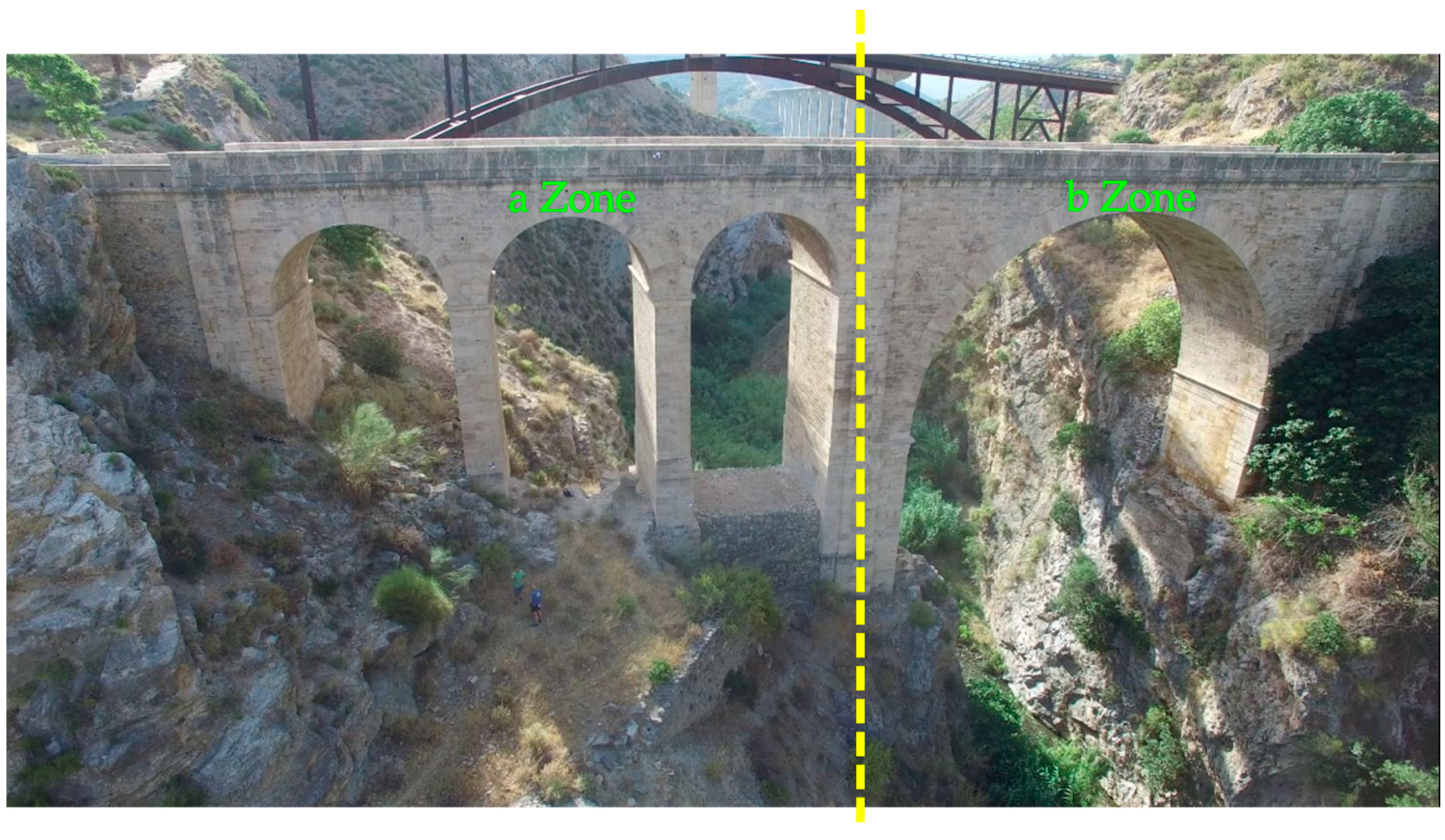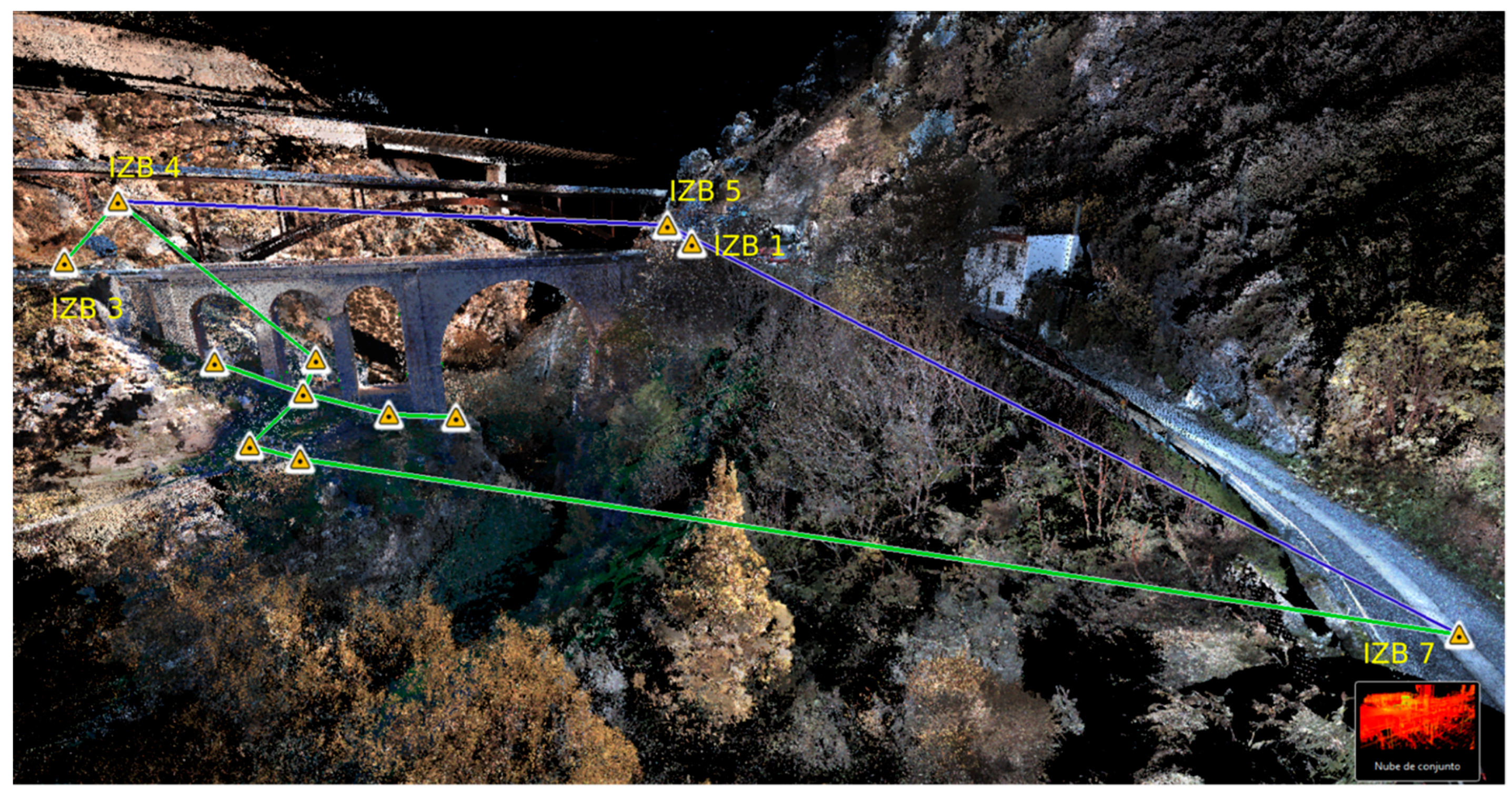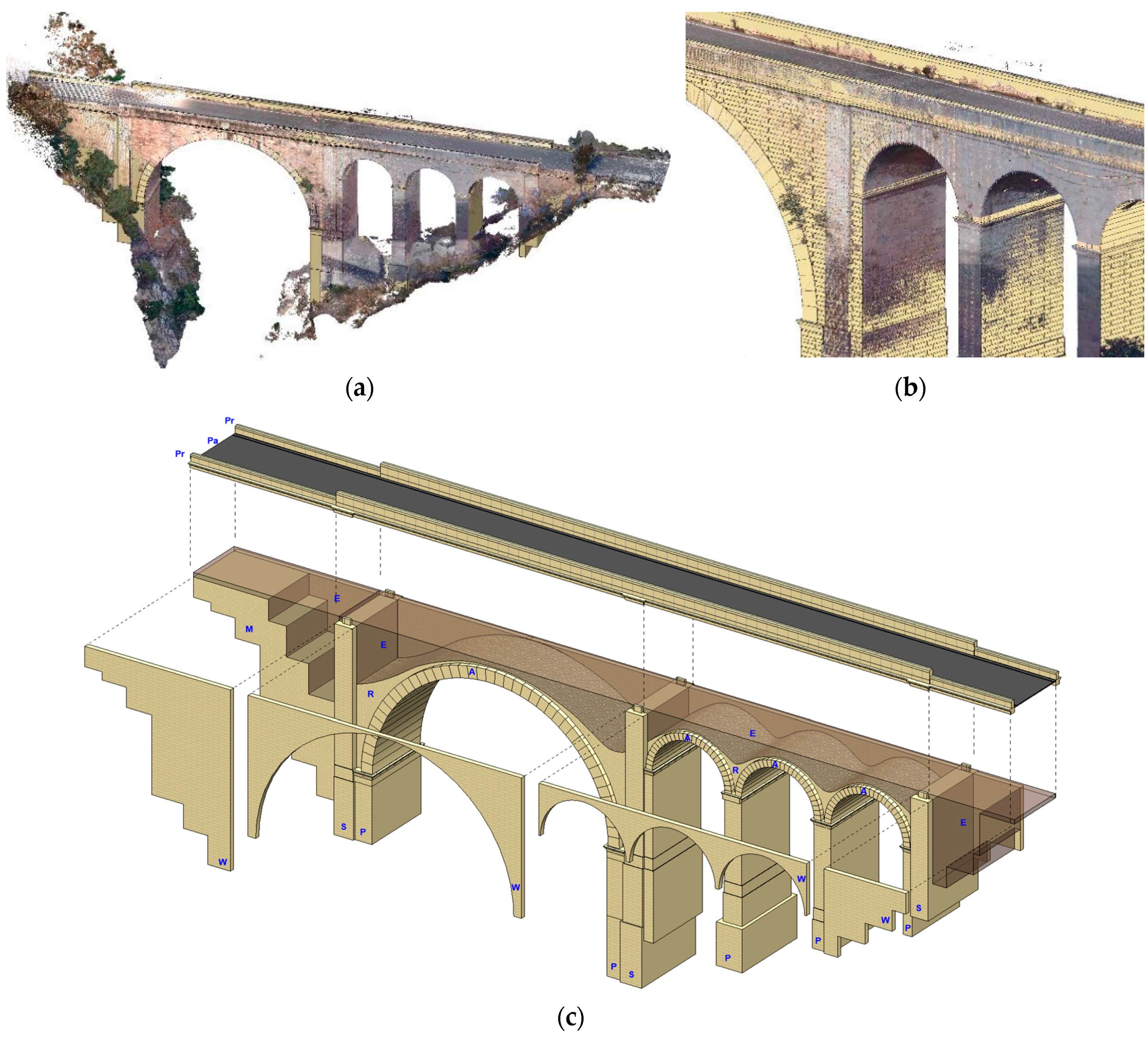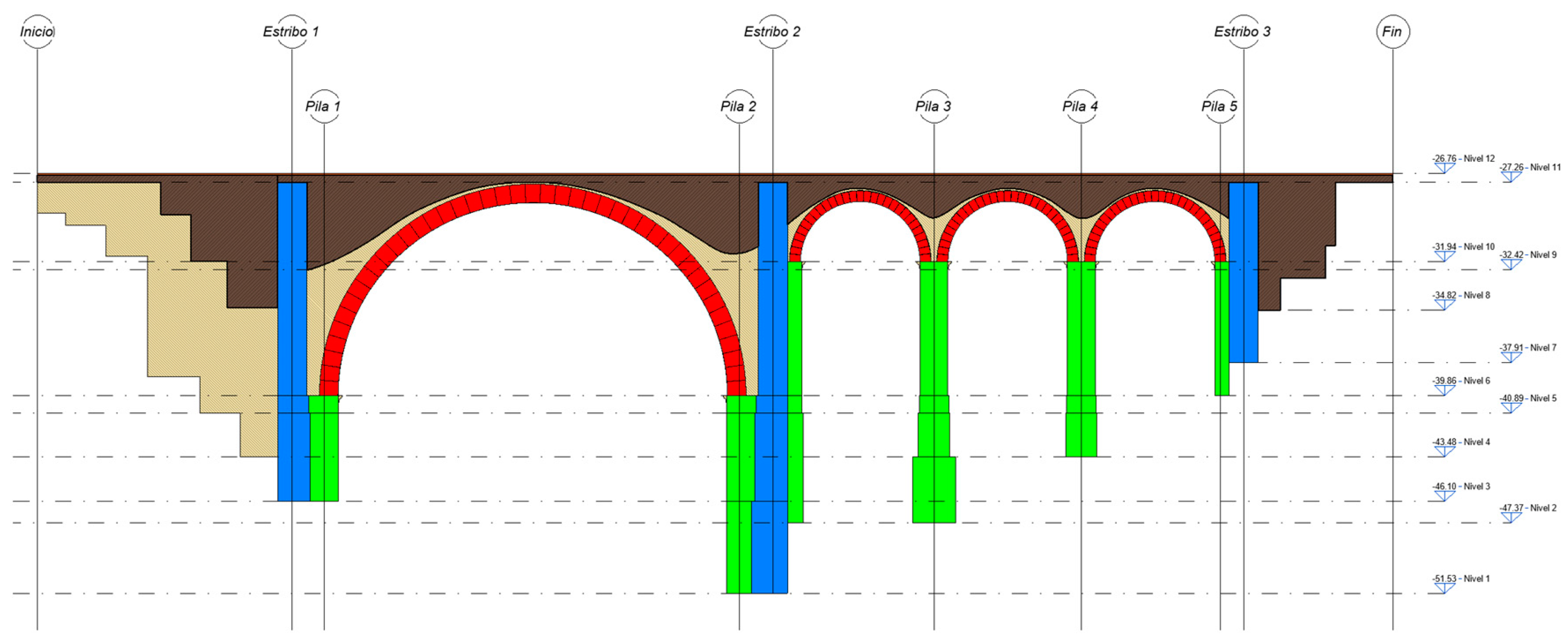Heritage Building Information Modeling (H-BIM) Applied to A Stone Bridge
Abstract
:1. Introduction
History and Description of Ízbor Bridge
2. Materials and Methods
2.1. Point Cloud Captured
2.2. Heritage Building Information Modeling (H-BIM)
3. Results and Discussion
4. Conclusions
Author Contributions
Funding
Acknowledgments
Conflicts of Interest
References
- Murphy, M.; Corns, A.; Cahill, J.; Eliashvili, K.; Chenau, A.; Pybus, C.; Shaw, R.; Devlin, G.; Deevy, A.; Truong-Hong, L. Developing historic building information modelling guidelines and procedures for architectural heritage in Ireland. In Proceedings of the The International Archives of the Photogrammetry, Remote Sensing and Spatial Information Sciences, Ottawa, Canada, 1 August 2017; Volume XLII-2/W5, pp. 539–546. [Google Scholar]
- Logothetis, S.; Delinasiou, A.; Stylianidis, E. Building information modelling for cultural heritage: A review. In Proceedings of the ISPRS Annals of the Photogrammetry, Remote Sensing and Spatial Information Sciences, 25th International CIPA Symposium, Taipei, Taiwan, 31 August–4 September 2015. [Google Scholar]
- Osello, A.; Lucibello, G.; Morgagni, F. HBIM and virtual Tools: A new chance to preserve architectural heritage. Buildings 2018, 8, 12. [Google Scholar] [CrossRef]
- Stober, D.; Žarnić, R. Application of HBIM as a research tool for historical building assessment. Civ. Eng. J. 2018, 4, 7. [Google Scholar]
- Bianchini, C.; Inglese, C.; Ippolito, A. The role of BIM (building information modeling) for representation and managing of built and historic artifacts. Disegnarecon 2016, 9, 10–11. [Google Scholar]
- Bianchini, C.; Nicastro, S. The definition of the level of reliability: A contribution to the transparency of historical-bim processes. Dienne 2018, 2, 46–60. [Google Scholar]
- López, F.; Lerones, P.; Llamas, J.; Gómez-García-Bermejo, J.; Zalama, E. A review of heritage building information modeling (H-BIM). Multimodal Technol. Interact. 2018, 2, 21. [Google Scholar] [CrossRef]
- Succar, B. Building information modelling framework: A research and delivery foundation for industry stakeholders. Autom. Constr. 2009, 18, 357–375. [Google Scholar] [CrossRef]
- King, T.F. The Archaeological Survey: Methods and Uses; Heritage Conservation and Recreation Service, U.S. Department of the Interior: Washington, DC, USA, 1978. [Google Scholar]
- Garagnani, S.; Manferdini, A.M. Parametric accuracy: Building information modeling process applied to the cultural heritage preservation. Int. Arch. Photogrammetr. Remote Sens. Sp. Inf. Sci. 2013, XL-5/W1, 87–92. [Google Scholar]
- Murphy, M.; McGovern, E.; Pavia, S. Historic building information modelling-adding intelligence to laser and image based surveys. ISPRS J. Photogrammetr. Remote Sens. 2013, 76, 89–102. [Google Scholar]
- Barber, D.; Mills, J. 3D Laser Scanning for Heritage. Advice and Guidance to Users on Laser Scanning in Archaeology and Architecture, 2nd ed.; Historic England: Swindon, UK, 2007. [Google Scholar]
- Anil, E.B.; Tang, P.; Akinci, B.; Huber, D. Deviation analysis method for the assessment of the quality of the as-is building information models generated from point cloud data. Autom. Constr. 2013, 35, 507–516. [Google Scholar] [CrossRef]
- Snavely, N.; Seitz, S.M.; Szeliski, R. Modeling the world from internet photo collections. Int. J. Comput. Vis. 2008, 80, 189–210. [Google Scholar] [CrossRef]
- Pritchard, D.; Sperner, J.; Hoepner, S.; Tenschert, R. Terrestrial laser scanning for heritage conservation: The cologne cathedral documentation project. ISPRS Ann. Photogramm. Remote Sens. Spat. Inf. Sci 2017, 4. [Google Scholar] [CrossRef]
- Shanoer, M.M.; Abed, F.M. Evaluate 3D laser point clouds registration for cultural heritage documentation. Egypt. J. Remote Sens. Sp. Sci. 2018, 21, 295–304. [Google Scholar] [CrossRef]
- Rodríguez-Moreno, C.; Reinoso-Gordo, J.F.; Rivas-López, E.; Gómez-Blanco, A.; Ariza-López, F.J.; Ariza-López, I. From point cloud to BIM: An integrated workflow for documentation, research and modelling of architectural heritage. Surv. Rev. 2018, 50, 212–231. [Google Scholar] [CrossRef]
- Reinoso-Gordo, J.; Rodríguez-Moreno, C.; Gómez-Blanco, A.; León-Robles, C. Cultural heritage conservation and sustainability based on surveying and modeling: The case of the 14th century building Corral del Carbón (Granada, Spain). Sustainability 2018, 10, 1370. [Google Scholar] [CrossRef]
- Cheng, L.; Chen, S.; Liu, X.; Xu, H.; Wu, Y.; Li, M.; Chen, Y.; Cheng, L.; Chen, S.; Liu, X.; et al. Registration of laser scanning point clouds: a review. Sensors 2018, 18, 1641. [Google Scholar] [CrossRef]
- Meydenbauer, A. Handbuch der Meßbildkunst in Anwendung auf Baudenkmäler und Reiseaufnahmen; Knapp Verlag: Halle, Germany, 1912. [Google Scholar]
- Westoby, M.J.; Brasington, J.; Glasser, N.F.; Hambrey, M.J.; Reynolds, J.M. ‘Structure-from-Motion’ photogrammetry: A low-cost, effective tool for geoscience applications. Geomorphology 2012, 179, 300–314. [Google Scholar] [CrossRef] [Green Version]
- Lowe, D.G. Distinctive image features from scale-invariant keypoints. Int. J. Comput. Vis. 2004, 60, 91–110. [Google Scholar] [CrossRef]
- Klein, L.; Li, N.; Becerik-Gerber, B. Imaged-based verification of as-built documentation of operational buildings. Autom. Constr. 2012, 21, 161–171. [Google Scholar] [CrossRef]
- BIMforum 2013. Available online: http://bimforum.org/wp-content/uploads/2013/08/2013-LOD-Specification.pdf (accessed on 5 November 2018).














© 2019 by the authors. Licensee MDPI, Basel, Switzerland. This article is an open access article distributed under the terms and conditions of the Creative Commons Attribution (CC BY) license (http://creativecommons.org/licenses/by/4.0/).
Share and Cite
León-Robles, C.A.; Reinoso-Gordo, J.F.; González-Quiñones, J.J. Heritage Building Information Modeling (H-BIM) Applied to A Stone Bridge. ISPRS Int. J. Geo-Inf. 2019, 8, 121. https://0-doi-org.brum.beds.ac.uk/10.3390/ijgi8030121
León-Robles CA, Reinoso-Gordo JF, González-Quiñones JJ. Heritage Building Information Modeling (H-BIM) Applied to A Stone Bridge. ISPRS International Journal of Geo-Information. 2019; 8(3):121. https://0-doi-org.brum.beds.ac.uk/10.3390/ijgi8030121
Chicago/Turabian StyleLeón-Robles, Carlos A., Juan F. Reinoso-Gordo, and Juan J. González-Quiñones. 2019. "Heritage Building Information Modeling (H-BIM) Applied to A Stone Bridge" ISPRS International Journal of Geo-Information 8, no. 3: 121. https://0-doi-org.brum.beds.ac.uk/10.3390/ijgi8030121




